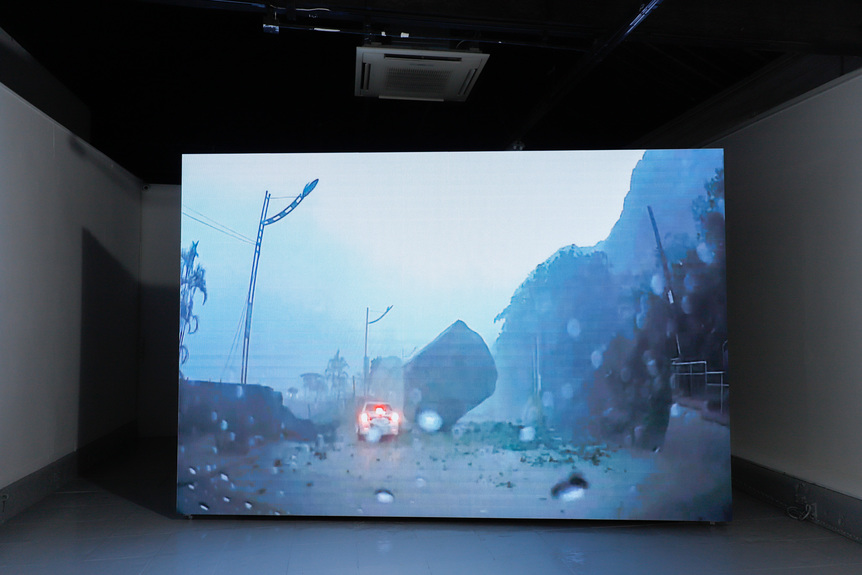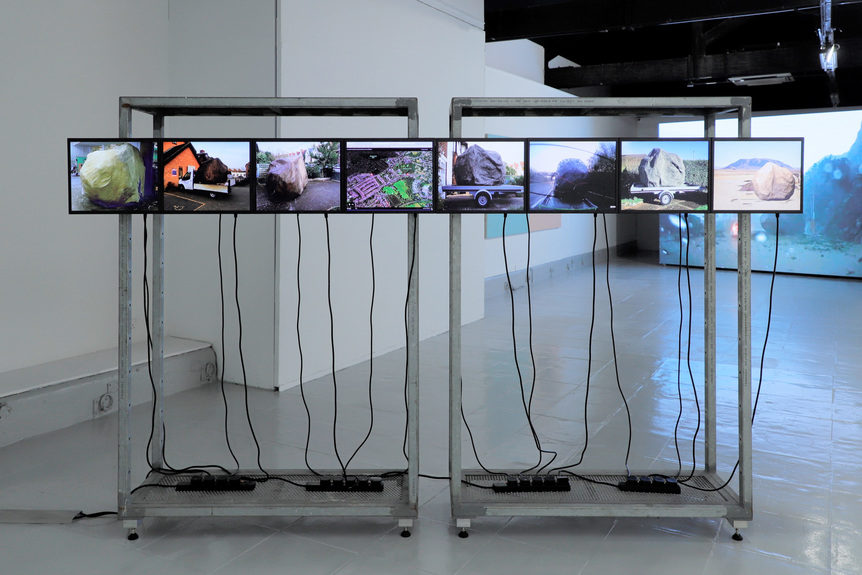-
From Current Issue
-
- Editor’s Letter Fire in the Heart
- Reviews I Gusti Ayu Kadek Murniasih
- Reviews 11th Seoul Mediacity Biennale: “One Escape at a Time”
- Dispatch Networked China
- One on One Monira Al Qadiri on Yukio Mishima
- Essays The rise of independent art spaces in pandemic-era Shanghai
- Features Tuan Andrew Nguyen
- Table of Contents
- Web Exclusives
- Archive
- Subscribe

R
E
V N
E
X
T
Installation view of LOUIS NIXON’s “Beyond Matter,” at 1a Space, Hong Kong, 2020. All images courtesy 1a Space.
Earth is defined as a rocky planet. Its solid surface of various kinds of rocks not only composes the physical landscape that nurtures life, but also brings a geographical dimension to the human understanding of the world. Inspired by the materiality of rock, Louis Nixon’s latest solo exhibition, “Beyond Matter,” at Hong Kong’s 1a Space, showcased the locally based artist’s experiments with this universal yet unique substance.
One’s first experience of the exhibition was sonic rather than visual. Emanating from a three-meter-high LED wall situated at the entrance was the deafening sound of heavy objects colliding with the ground. This was the soundtrack to a short film entitled Falling Rock (2020). Through the lens of a car dashcam, the film captures an astounding scene of a giant rock falling from the mountain onto the highway, almost crashing into a moving car. The footage, documenting an episode from the 2018 Hualien earthquake in Taiwan, was uploaded by an anonymous user and later discovered by the artist on the Internet. The audio track, on the other hand, was fabricated by the artist as an imagined soundscape of this catastrophic event. Void of any background noise, the track shadows the film with a sense of artificiality, inviting the audience to question the visual authenticity of the spontaneous and shocking incident represented on screen.
Hanging across three walls were Floating (2018–20), a series of paintings depicting different magnified geological objects. Among them are a meteor, moon rock, silicon crystal, and others, hailing from different eras and places in the universe. These paintings possess a realistic and refined quality when one is observing from afar, yet upon closer inspection, the sketchy brushstrokes make them more akin to a series of drawing studies of the objects’ surface textures. In contrast to the three-dimensional depictions of the objects themselves, their backgrounds are rendered in flat, vibrant monochrome, with shades echoing Hong Kong’s colorful architectural landscape, bridging this body of work with the local context.
At the end of the room stood a video installation entitled Moving Rock (2017–20). Mounted on both sides of a long, narrow, metal shelf were 16 screens playing a series of videos documenting a kinetic rock that the artist had made. The front row of screens shows from different angles the giant rock moving across the floor of an empty industrial building. Its effortless sliding motions belie its massive volume, raising questions about the heavy and compact nature we often associate with rock. On the other side of the shelf, the rest of the videos revealed the mechanism behind the object’s mysterious movements. Built with a hollow core, the “rock” is actually made of a pile of wooden sticks as its inner structure and a skin of textured, rock-like resin, thus making the object relatively light and easy to move. The making of the sculpture was a process of studying and replicating a surface in order to craft the illusion of an actual rock.
One of the videos in Moving Rock presents a particularly intriguing vignette. The artist had been storing his kinetic rock in a yard, which Google Street View surprisingly captured. The video shows a screen recording of the artist browsing the webpage, zooming in and out between a close-up of his kinetic rock and a view of the entire Earth from outer space, situating this manmade object in a globalized digital landscape where the artificial is indistinguishable from the natural. This dynamic, hinted by the exhibition title, encapsulates the artist’s practice, which seeks to uncover new ways of understanding his chosen material, and explore what is within and also beyond matter.
Louis Nixon’s “Beyond Matter” is on view at 1a Space, Hong Kong, until October 25, 2020.
To read more of ArtAsiaPacific’s articles, visit our Digital Library.



















